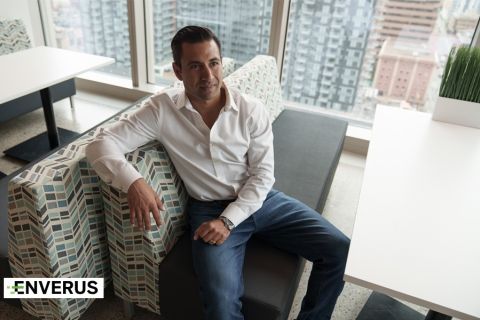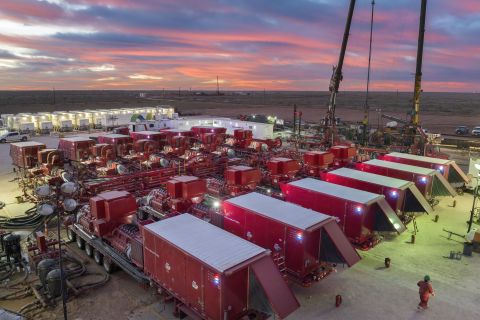Jaxon Caines, technology editor, Hart Energy: I am Jaxon Caines, and I'm here with Gary Yeoman of Balmoral at the 2024 Offshore Technology Conference to discuss the company with them. To start things off, what are some of the trends you've been seeing over the past decade in the offshore energy industry, and what are some of the things that you expect to continue?
Gary Yeoman, sales director, Balmoral: Over the last five years, 10 years, we've seen great change in the offshore energy industry. There is a huge emphasis now on offshore wind, both fixed and floating. Oil and gas still plays a key part of that, and we see that continuing for some time. However, there has been a huge focus on offshore wind for Balmoral experts in buoyancy and protection products in the subsea environment. There is a huge opportunity for us to take those skills, knowledge and track record experience, and transition that across and into the offshore wind sector. So, the market is extremely buoyant, both from an oil and gas perspective, but there is a huge focus here at the show this week on renewable energy. We look forward to participating in that moving forward. We believe we have a number of products, a number of solutions, both new and existing, that we can take to that market and capitalize on the opportunities that are available to us. But over the last five years to 10 years in particular, there has been a huge focus now in offshore wind, both fixed and floating.
JC: I'm glad you brought up buoyancy because that leads us to my next question. I'd like to know, what are some of the challenges you guys have had when it comes to developing and designing some of these buoyancy or insulation products, and how have you sort of gotten over those humps?
GY: We've invested heavily in our R&D. We have a hydrostatic test center in our facility in Aberdeen, Scotland that allows us to trial and test our products before we actually take them to market. We've supplied buoyancy products to some of the deepest harshest deepwater environments around the world. So it's really important that we do a lot of good engineering work, R&D work and testing to make sure that the products can withstand the environment that they're operating within. A lot of investment has been made over a number of years. Huge amount of experience from an engineering and delivery perspective. And as I say, we've supplied projects around the globe to some deep water projects. The buoyancy product itself will be very similar within the floating offshore wind market. So again, we look to transition skills and knowledge across that new sector as the market develops in the future.
JC: How has legislation and regulation and things of that nature played a role in the way you guys develop your technologies?
GY: Well, obviously the governments around the world have all got net zero targets that they're looking to achieve, both up to 2030, then maybe 2045. Now, to be fair, a number of those targets will actually slip back because they were very ambitious, but it helps push that agenda towards net zero. We [Balmoral] will play a key part in that going forward. As I said earlier, we have a number of products that will be suitable into that sector, so we're very well placed. We engage with a number of the industry associations around the world who have direct links with governments and governmental bodies who obviously push the agenda from a supply chain perspective. We have direct roots, or you could say indirect roots if you wish, through some of the industry associations that we are part of. We participate at their events around the world, and we look forward to a very positive future for the energy market.
JC: Keeping with the theme of the future, how has Balmoral specifically helped to reach sustainability goals and net zero goals? And what are some initiatives you guys are looking to roll out to reach those goals?
GY: It is not just the products that we supply to these green projects. We are very conscious of the material consumption, the usage of our materials, how we transport our materials, how we procure our energy for our manufacturing facility as well. The energy that we use and consume in the manufacturer of our products actually come from green sources as well. So our ESG strategy is at the forefront of everything that we do now, along with health and safety and quality. The ESG side of things is very important to us, so it carries a key focus for our business going forward. We believe that this will become more and more important, so to be at the forefront of that now should stand us in good stead in the future.
JC: Now, are there any specific technologies or things you can speak about that you guys are rolling out?
GY: Our new Hex defense product displayed on the wall here is a scour protection system that we think will be a game changer for the market. It's technology that we've adopted from oil and gas and are now applying to renewables. It's a really good example of that transition story. So, we think that'll be a big game changer and we hope to have one in the water later this year. And what that will do is reduce the scour erosion around the jacket or the monopile. It will help protect the cables, it will eliminate the need for rock, which is obviously quite expensive to transport and deploy in projects around the world. So it's something that we're really quite excited about and look forward to, as I said, getting one in the water later this year hopefully.
JC: I'm Jaxon Caines, and that was your Hart Energy Exclusive interview with Balmoral. Check back with us at hartenergy.com.
Recommended Reading
Enverus Names Manuj Nikhanj as New CEO
2024-05-29 - Enverus President Manuj Nikhanj will take over as CEO of the top energy analytics firm on July 1, succeeding Jeff Hughes, who will continue as executive chairman.
OTC: E&Ps Improving Operational Safety with Digitization
2024-05-13 - Artificial intelligence and the digitization of the oilfield have allowed for several improvements in keeping operators out of harm’s way, panelists said during the 2024 Offshore Technology Conference.
Cracking the Fracking Code: Efficient Approaches to Optimize Wellbores
2024-06-30 - Technology and process innovations improve operational efficiencies even as companies scramble for greener fracking solutions.




